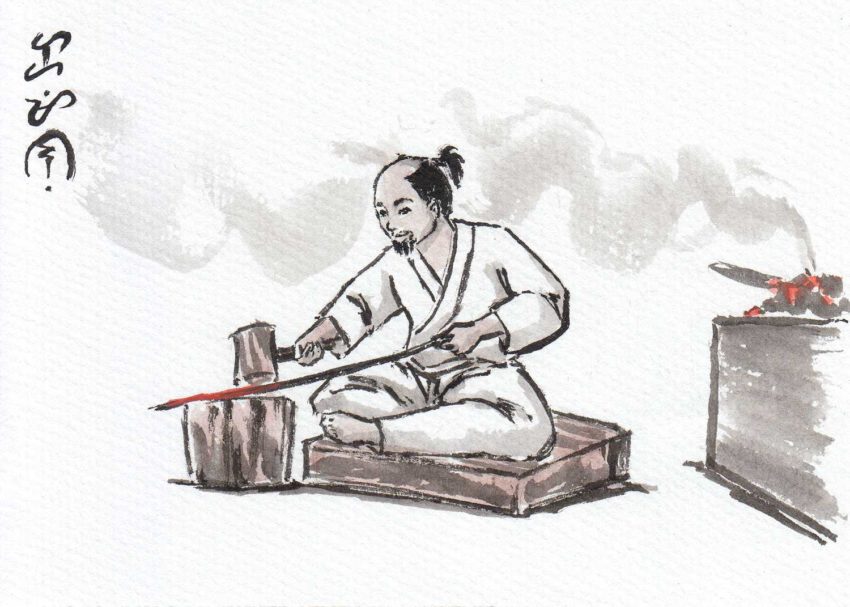The soul of the samurai is his sword, and no other Japanese sword is as iconic as the katanaKATANA 刀 "sword" learn more.... In fact, the katana could be considered one of the most iconic swords in all of worldwide popular culture. In keeping with the spirit of the great importance of katanas, the craftsmanship that went into a fighter’s sword was vital. Famous Japanese sword makers are still renown for the beauty of their creations– graceful curves, impossibly sharp edges, gorgeous details in every inch.
The poetic image of a serene, yet tense, samuraiSAMURAI 侍 "warrior serving a lord" learn more... duel is absolutely timeless – so much so that samurai duels in classic Kurosawa movies were a direct influence on spaghetti westerns. Quick draws at high noon wouldn’t be as popular if it weren’t for warlords’ duels in the land of the rising sun. But, while popular culture would have you believe these swords were godly super weapons that could cut through thirty men at once, the truth is, samurai often preferred to fight with their bow or spear. Swords were often just used for dueling, for ceremony, or as a last resort, a last-ditch backup weapon on the battlefield.
Regardless, Japanese swords remain as popular as ever. They have great cultural significance in Japan. Countless museums have various types of swords on display, often from famous Japanese sword makers whose names echo throughout the Japanese psyche still. As samurai ideals and code are adopted by modern-day Japanese businessmen, the samurai sword remains a symbol for those same traditions. As a result, and thanks to the Japanese sword’s popularity around the world, a hand-crafted, steel-forged katana has become a prized feature of many a sword collection. Due to the difficult, lengthy process of properly forging a katana, as well as tight Japanese regulations of sales and exporting, real Japanese-made swords can be quite valuable.
How Japanese Sword Makers Ply Their Craft
Before breaking down the most famous Japanese sword makers, both historically and in modern times, you should keep in mind some details of the extreme craftsmanship that goes into one of these masterpieces.
A week-long process of smelting iron sand into the usable tamahaganeTAMAHAGANE 玉鋼 "jewel steel" learn more..., or “jewel steel”, that is required to make a sword. From there, the master Japanese sword smith, along with his team of apprentices, will work for weeks or even months on a single sword. The part of the process that is usually best-known is the folding of the steel. This requires repeatedly heating, folding, and hammering the steel both to strengthen the steel as well as remove impurities.
The entire Japanese sword making process is considered a sacred art. Traditionally, many Shinto rituals will be performed during the process, transforming the blade into a sacred item for its eventual owner and the owner’s family. It will be passed down as an heirloom with each new generation.
The Most Famous Japanese Sword Makers
Now that you have a sense of the iconic cultural significance of the Japanese sword, as well as the painstaking process and artistry that goes into one, here are some of the most famous Japanese sword makers of the past and present:
Masamune: The Most Famous Of All
No list of famous Japanese sword smiths would be complete without Masamune. Without question, he was the most famous in history. While it is not known exactly when he was alive, historians believe it was somewhere during the 13th or 14th century. It was he who pioneered the legendary method of refining and blending the steel, which is the process all serious Japanese sword makers still use to this day. You can even see the influence in this revolutionary sword making process in the creation of high end Japanese kitchen knives.
There are countless stories and bits of mythology surrounding Masamune. All of this continues to add mystery to the question of just exactly who he was, as well as to the mystique of the swords he forged. On top of that, many (but not all!) of the legendary weapons he created have been lost. Only their stories remain.
The Legendary “Hojo Masamune” Sword
One of the most famous examples of Masamune’s work is a sword called Hojo Masamune. It is known as one of the best Japanese swords ever made. It was, in fact, said to be perfect. It had one of the sharpest-ever edges and was perfectly balanced. Because this famous sword was such a prized possession, it was passed down from generation to generation within the Tokugawa shogunSHOGUN 将軍 "medieval military commander" learn more... family. It was in the family when the Tokugawas came to power in the 1600s, and remained protected until it was named one of Japan’s national treasures in 1939.
During the American occupation of Japan following World War II, the ownership of swords became illegal. The head of the Tokugawa family at the time, diligently following the new law, took the prized sword down and turned it in at the local police station. It was duly recorded in official documents… and never seen again.
Frustratingly, Masamune didn’t usually sign his swords like many of the most famous Japanese sword makers did, so the chances of this legendary sword ever turning up again are very slim since it is hard to identify, especially by non-experts. It is likely lost forever and was possibly even melted down with many other swords after the war. The awesome Hojo Masamune might have ended up a molten blob thanks to some American military officer, doing his job and completely unaware of the significance of the national treasure.
Or, perhaps the sword survives in a secret collection somewhere in the world. Maybe it became a family heirloom to another, unknown family after World War II, one unaware of the importance of the old sword in their possession. One can only hope such a work of art has survived and will one day be found again, much like the Mona Lisa.
While Masamune is the most famous Japanese sword maker of all time, one other Japanese sword maker in history comes close.
Muramasa: So Good He’s Evil
If Masamune was the honorable swordsmith employed by famous families in feudal Japan, Muramasa contrasts perfectly as the darker, even more mysterious swordsmith. His swords, according to legend, are infamously supernatural and even cursed. Famous Japanese sword makers include reputations of all types.
While Masamune and Muramasa did not live at the same time and thus did not directly compete, the two men are considered “historical rivals,” competing for who has the most legendary and mystical stories surrounding their epic swords.
During his life, Muramasa’s swords were actually similar in recognition to Masamune. His “Muramasa edge” was known to be of the highest quality. The thicker steel near the sword’s tang was also known to provide great balance.
It was only later, after the great Muramasa’s death, that many strange events led to stories about his cursed swords.
Like Masamune blades, Muramasa blades were quite popular with members of the Tokugawa shogunate. But after too many accidental cuts, stabs, and even deaths involving Muramasa swords, they began to get the reputation of being possessed by demons. The term “Muramasa” even became popular in Japanese theater in reference to any demon-possessed killer. The swords were so strongly considered bad luck by the members of the Tokugawa clan that they were actually banned from use.
Later, during the Japanese civil war, Murasama swords spiked again in popularity as the weapon of choice by enemies of the Tokugawa shogunate. It was believed that the demon-possessed swords were still thirsty for the blood of the Tokugawa.
There are more legends surrounding Muramasa’s swords. Since Muramasa lived after Masamune, it is said (in one version of the story) that Muramasa once went to a river and dipped in two swords – one of his own, and one of Masamune’s. The edges of both swords easily cut through any dead leaves or other debris as it passed. But Masamune’s sword wouldn’t cut through living fish – creatures that were, after all, considered peaceful and innocent. Muramasa’s sword, being evil and ruthless with no regard for propriety, was happy to cut through any living things that passed its deadly blade.
Another legend is that Japanese sword sharpeners were terrified of ever having to hone a Muramasa sword. The blades were said to be so sharp that if a sword maker slipped he would lose a finger – but would then continue his work the rest of the day, completely unaware of his having severed a digit.
A rare Muramasa sword is an absolute prize in any collection, but due to the legendary curses surrounding them not a single one has ever been officially given the title of national treasure.
Yoshindo Yoshihara: A Modern-Day Swordsmith
It’s not just eras from centuries ago that produced famous Japanese sword makers. Today in Japan, sword making is still considered an important cultural heritage. To become a modern-day swordsmith, you have to apprentice with a master for five or more years, and you must then forge a katana in front of a panel of judges. Because of this, as well as the fact that many modern sword making techniques are passed down by families over generations, finding true great masters is uncommon.
The most famous modern-day master sword maker is Yoshindo Yoshihara. His family has made traditional Japanese swords for over ten generations, making it one of the longest Japanese sword making lineages that has survived to modern times. Yoshihara makes katanas completely traditionally. No modern equipment or materials are used. He is one of the few sword makers to still use tamahagane steel. Up until the 1970s he made all of his swords in Masamune’s Soshu tradition. He has since switched his style to that of the Bizen tradition.
And the future of sword making is in good hands as Yoshihara has trained nine apprentices. One of these acolytes is his son, Yoshikazu, who will carry on the family name and tradition.
There is no doubt that Japanese swords are here to stay as a cultural phenomenon, and as an extremely popular item for collectors around the world. And without the master sword makers of the past and the ones that currently carry on the traditions, Japanese swords might not hold the legendary status that they do. If you’re a love of historical Japanese blades, spare a reverent thought for the skill and dedication and talent of the most famous Japanese sword makers of history.

